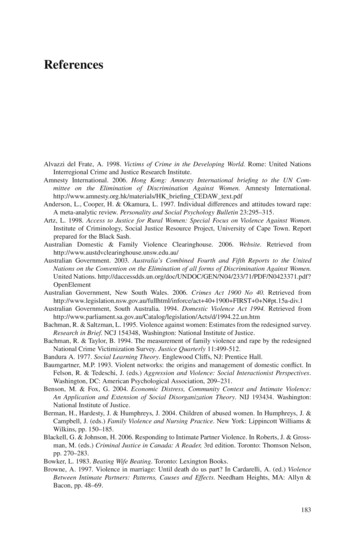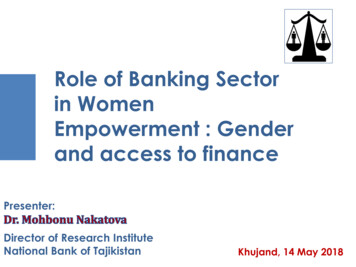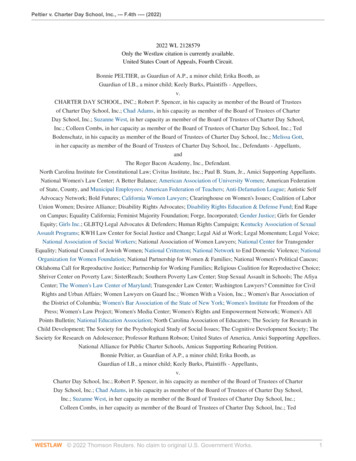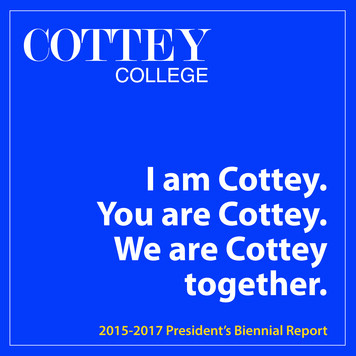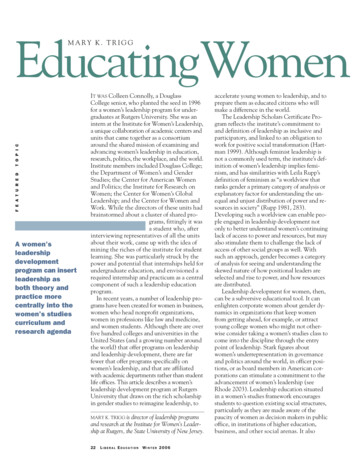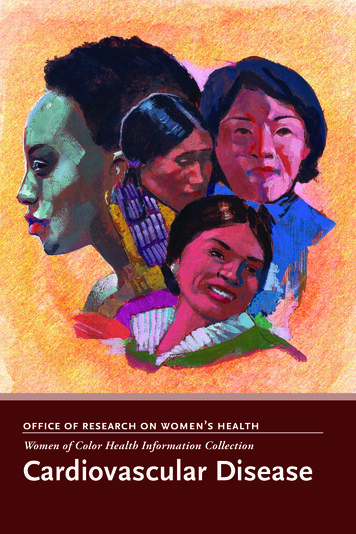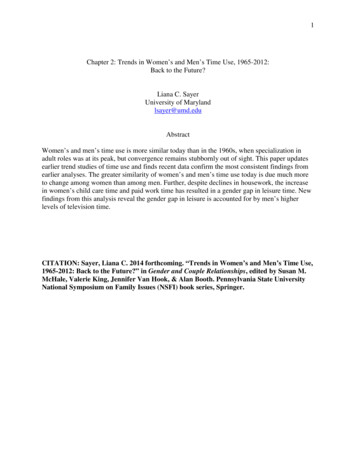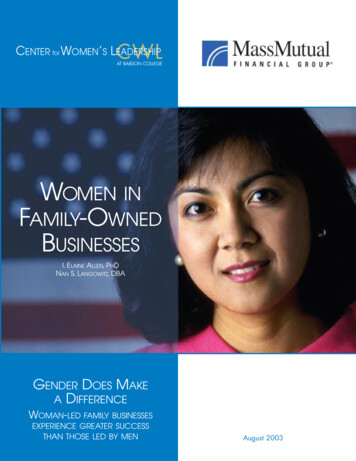
Transcription
CWLCENTER for WOMEN’S LEADERSHIPAT BABSON COLLEGEWOMEN INFAMILY-OWNEDBUSINESSESI. ELAINE ALLEN, PHDNAN S. LANGOWITZ, DBAGENDER DOES MAKEA DIFFERENCEWOMAN-LED FAMILY BUSINESSESEXPERIENCE GREATER SUCCESSTHAN THOSE LED BY MENAugust 2003
August 2003Dear reader,Family-owned businesses are the lifeblood of American business, accounting for 80% to 90% of all businesses inNorth America.* Family businesses account for 78% of all new jobs, 65% of all wages paid, and 60% of totalU.S. employment, and contribute more than 50% of the GDP.**Increasingly, women are playing a larger role in the leadership of family businesses. In 1997, the MassachusettsMutual Life Insurance Company (MassMutual) funded a research study that gave an indication of the changingrole of women. In that study, more than 25% of family businesses responded that they expected their next CEOto be a woman.Six years later, in early 2003, the MassMutual Financial Group/Raymond Institute American Family BusinessSurvey was published, which analyzed planning, growth, and succession issues of family businesses in detail.The survey results indicated significant changes from MassMutual’s original 1997 survey. Specifically, wefound that the percentage of firms expecting their next CEO to be female had grown dramatically, from 25% in1997 to 34% in 2002. What’s more, the number of firms with female CEOs had doubled in the sametime period.The following Babson College/MassMutual report, Women in Family-Owned Businesses, more closely analyzesthe 2002 survey data, comparing and contrasting the businesses owned by women versus men. This groundbreaking, first look at what makes woman-owned family businesses different was led by the Center for Women’sLeadership at Babson College, the first academic center at a leading school of management dedicated to theadvancement of women in business and entrepreneurship. MassMutual’s support of this study is a reflection ofits ongoing commitment to helping women achieve their financial goals.Clearly, gender is making a greater difference today than ever before. This study indicates that woman-ownedfamily businesses are nearly twice as productive as those owned by men. The findings point to the numerousdifferences in leadership and management styles that contribute to the success of woman-owned family firms.Women have made great strides in the business world, and they are building on their successes at a tremendouspace. Read on.Susan A. AlfanoExecutive Vice PresidentMassMutual Corporate OperationsDr. Nan LangowitzCofounder & Faculty DirectorCenter for Women’s Leadership at Babson College* Family Business Review, 1996** Financial Planning, Nov. 1999Babson College/MassMutual Financial GroupWomen in Family-Owned Businesses Report1
TABLE2OFCONTENTSOur Commitment to Women3Executive Summary4Business Characteristics of Female-Owned Family Firms6Family Characteristics of Female-Owned Family Firms8Leadership, Governance, and the Future10Lessons from Women in Family-Owned Businesses12Survey Methodology13Appendix: Gender Differences in Family-Owned Businesses14Acknowledgments19About the Survey Team20BABSON COLLEGE/MASSMUTUAL FINANCIAL GROUPWomen in Family-Owned Businesses Report
OUR COMMITMENTTO WOMENCENTER FOR WOMEN’S LEADERSHIPAT BABSON COLLEGEMASSMUTUAL FINANCIAL GROUPWOMEN'S MARKET INITIATIVEThe Center for Women’s Leadership at BabsonCollege is the first center dedicated to women inbusiness and entrepreneurship at a leading school ofmanagement. Through educational programs andresearch, the Center develops women’s leadershipskills and promotes the advancement of women asentrepreneurs and entrepreneurial leaders within corporations and not-for-profit organizations. The Centerfor Women’s Leadership collaborates with companiesand business-related organizations to understand theissues that contribute to women’s leadership success inbusiness and entrepreneurship.MassMutual Financial Group is dedicated to helpingwomen meet their financial goals. To that end, thecompany has created a Women’s Markets Initiative toguide the company in delivering its message of financial achievement and empowerment to women, andto help the company better attract female financialservices professionals and aid them in developing asuccessful career with MassMutual.Babson College supports entrepreneurs on theirjourneys to build and grow successful enterprises.The College has been a pioneer in entrepreneurialeducation since its inception in 1919, offering aninnovative curriculum that helps students developwell-rounded leadership and management skills.While conventional thinking defines entrepreneurshipas starting and running a business, Babson believesthat having sharp entrepreneurial skills is vital for thesuccess of any business—large or small, public orprivate, corporate or not-for-profit, local or global.The College offers BS, MBA, and custom MS andMBA degrees through its undergraduate program andthe F.W. Olin Graduate School of Business at BabsonCollege. Executive development programs are offeredto experienced managers worldwide through BabsonExecutive Education. Babson College is proud to havebeen recognized as a world leader in entrepreneurialeducation by U.S. News & World Report, the FinancialTimes, and The Wall Street Journal.MassMutual Financial Group/RaymondInstitute American Family BusinessSurvey Team:Joseph H. Astrachan, Ph.D., Director, Cox FamilyEnterprise Center at Kennesaw State University andDistinguished Research Chair of Family Business atLoyola University Chicago; I. Elaine Allen, Ph.D.,Kevern R. Joyce Term Chair and Associate Professorof Statistics and Entrepreneurship, Babson College;Stephen Spinelli Jr., Ph.D., Director, Arthur M. BlankCenter for Entrepreneurship at Babson College; andCarol B. Wittmeyer, Ed.D., President, George andRobin Raymond Family Business Institute.Women in Family Business Team:I. Elaine Allen, Kevern R. Joyce Term Chair andAssociate Professor of Statistics and Entrepreneurship,Babson CollegeNan Langowitz, Faculty Director, Center for Women’sLeadership and Associate Professor of Management,Babson CollegeBABSON COLLEGE/MASSMUTUAL FINANCIAL GROUPWomen in Family-Owned Businesses Report3
EXECUTIVE SUMMARYWoman-owned businesses in the United States haveincreased by 14% in the last five years.1 In the sameperiod, the number of women owners of familybusinesses has increased by 37%.2 Female-ownedfamily businesses share common characteristicswith their male-owned counterparts. Female-ownedfamily businesses, like those owned by men, aresubstantial, well established, U.S. centered, andoperate in similar industries. The majority of thesebusinesses expect that the family will maintain control of the business in the years ahead and share anoptimistic view of the future. Woman-owned familybusinesses have some unique aspects that set themapart, however, and there are differences in theemployment and leadership of women amongmale- and female-owned firms. This report looks atthe influence of women as owners and leaders offamily-owned businesses.3 The findings in thisreport are based upon the results of the MassMutualFinancial Group/Raymond Institute American FamilyBusiness Survey, directed and supported by theLoyola University Chicago Family Business Center,the Cox Family Enterprise Center at Kennesaw StateUniversity, and Babson College.Highlights of the findings on woman-owned familybusinesses include: Female-owned family firms are typically 10 yearsyounger than male-owned firms and more arefirst-generation businesses Woman-owned family firms are more than twiceas likely to employ women family membersfull-time and nearly three times as likely to employmore than one female family member full-time Female-owned family firms rarely look outside thefamily for a chief executive and are far less likelyto do so than male-owned firms Fewer male than female owners of family businesses look to their spouse for chief executiveleadership Female-owned family firms experience greaterfamily loyalty to the business, agreement with itsgoals, and pride in the business than male-ownedfamily firms Woman-owned family firms have a 40% lowerrate of family member attrition in the business Female-owned family firms are more likely tohave chosen a successor chief executive thanmale-owned family firms, and that successor ismore likely to be a woman Woman-owned family firms have greater genderbalance in the composition of their boards ofdirectors The presence of a woman on the owner-management team of a family business is positively associated with the presence of a woman as CEO, thegender balance of the board of directors, and thechoice of a woman as successor CEO The owners of woman-owned family firmsassumed their roles as owners at an age fiveyears older than their male counterparts Female-owned family firms do more with less;they are nearly two times as productive asmale-owned family firms44The MassMutual Financial Group/Raymond Family Business Institute American Business Survey data set. Copyright 2002. The Raymond Family Business Institute and Massachusetts Mutual Life Insurance Company.All rights reserved. Used with permission.BABSON COLLEGE/MASSMUTUAL FINANCIAL GROUPWomen in Family-Owned Businesses Report
EXECUTIVE SUMMARYcontinued . Woman-owned family firms place greater proportionate emphasis on philanthropy and direct thatphilanthropy toward educational and communityorganizations Female-owned family firms may benefit byfunding future growth through levels of debtcomparable to those at male-owned firms More than two-thirds of woman-owned familybusinesses anticipate a positive future for theircompanies despite the current recessionaryconditionsOverall, woman-owned family businesses arethriving and changing the face of family firms inthe United States. Female ownership and leadershiphas increased the level of participation of womenfamily members as full-time employees of theirfamily businesses. They bring improved productivityto their businesses and a higher emphasis onphilanthropy to their communities. This can onlybode well for the future of family business inAmerica.1“Women-Owned Businesses in the United States: 2002,” Center for Women’s Business Research, Washington,D.C., 2002.2Based upon the 1997 Arthur Andersen/Mass Mutual American Family Business Survey and the Mass MutualFinancial Group/Raymond Family Institute American Family Business survey, the % of women owners increasedfrom 11.4% in 1997 to 15.6% in 2002, a 36.8% increase.3Tables in the report indicate statistically significant differences with boldface type.BABSON COLLEGE/MASSMUTUAL FINANCIAL GROUPWomen in Family-Owned Businesses Report5
BUSINESS CHARACTERISTICS OFFEMALE-OWNED FAMILY FIRMSWoman-owned family businesses are substantial, withaverage annual revenues of 26.9 million in 2002.The range in revenues reported was very wide, withone company reporting annual sales of 1 billion anda handful of the respondents indicating revenues of 400,000 or lower.Although female-owned firms are somewhat smaller insize compared with the average annual 30.4 millionin revenues of their male-owned counterparts, theygenerate their sales with fewer median employees,employing 26 individuals compared with 50 at maleowned firms. This means that female-owned familybusinesses are 1.7 times more productive than maleowned family firms. They do more with less.Female-owned family businesses are most frequentlyactive in the identical top industries in whichmale-owned firms most often operate, namelymanufacturing or wholesaling. However, the servicesector is the third leading industry for female-ownedbusinesses, whereas male-owned firms are next mostlikely to be in the construction industry. Nonetheless,both types of firms identify the same five industries astheir primary business sector.TOP FIVE INDUSTRIES FOR FAMILYBUSINESSESMale OwnerType of Retail625%7%13%16%12%Female Owner28%13%9%22%11%Woman-owned family businesses are typically10 years younger than those owned by menand, likely as a result, more are first-generationbusinesses. The most frequent median year ofbusiness founding is 1970 for a woman-ownedfirm, compared with 1960 for those owned bymen. Because of the relative youthfulness ofwoman-owned businesses, fewer of these businessesare third-generation firms. It’s possible that theyouthfulness of these businesses is a contributingfactor to the increased productivity noted above.% OF BUSINESSES BY GENERATIONOF FAMILY OWNERSHIPFirst generationSecond generationThird generationMale OwnerFemale Owner29%43%21%33%47%18%Similar to all family businesses, woman-owned familybusinesses maintain a strong U.S. market sales focus;nearly two-thirds report U.S. domestic sales as theirsole revenue source. Despite dependence on the U.S.economy, two-thirds of woman-owned firms havemaintained or grown their revenue levels, and less thanone-fifth have experienced sales drops of more than5%. Most firms have resisted trends to downsize theirorganizations, with the median number of employeesin woman-owned firms unchanged during the pastthree years. More than a quarter of respondents grewtheir firms’ revenue by more than 11%, despite theU.S. recessionary environment.BABSON COLLEGE/MASSMUTUAL FINANCIAL GROUPWomen in Family-Owned Businesses Report
BUSINESS CHARACTERISTICS OFFEMALE-OWNED FAMILY FIRMS continued .SALES REVENUE TRENDSAT FAMILY-OWNED FIRMSDEBT STRUCTURE INFAMILY-OWNED BUSINESSESMale OwnerFemale OwnerChange in sales revenue over the pastthree yearsIncreased by greaterthan 11%32%25%Increased from6% to 10%15%14%Increased from1% to 5%21%21%No change8%10%Decreased from1% to 5%8%13%Decreased by morethan 5%15%17%Male OwnerNo debt other thantrade payables28%Debt level between 1%and 25% of equity33%Female Owner32%31%Overall, female-owned firms have fared less well interms of revenue growth than those owned by males.Again, this may be linked to the relative youthfulnessof their firms. Less experience in the marketplacemay make it harder to rely on an establishedbusiness base to generate new sales opportunities.On the other hand, it is also the case that womanowned firms tend to be more fiscally conservative.More of these firms carry no debt, other than tradepayables, compared to male-owned firms. Suchfiscal conservatism may give them greater ability toweather adversity, but it foregoes the opportunity touse debt to finance growth. It is a matter of investigation whether the reduced use of long-term debtby woman-owned firms is due to barriers to accessfor credit, which have in the past been reported bywomen business owners and entrepreneurs, orsimply a slightly more risk-averse financial postureon the part of these owners. The use of financialleverage could be an important variable for the futuregrowth of woman-owned family businesses. Femaleowned firms may benefit by funding future growththrough levels of debt comparable to thoseat male-owned firms.BABSON COLLEGE/MASSMUTUAL FINANCIAL GROUPWomen in Family-Owned Businesses Report7
FAMILY CHARACTERISTICS OFFEMALE-OWNED FAMILY FIRMSOwners of family businesses are nearly the sameage, regardless of the gender of the owner. Womenowners, however, take on ownership of the businesslater in life than male owners—five years later onaverage. For those who are first-generation owners,it may be the case that women owners do not formtheir firms until their child-bearing and rearing yearsare coming to an end. This may also be a reasonwhy second- and third-generation owners mayforgo taking on family business responsibility untillater in life.CHARACTERISTICS OFFAMILY-BUSINESS OWNERSMale OwnerAverage age of ownerAverage number ofyears as ownerAverage age uponassuming ownershipFemale Owner595823173641Woman-owned family businesses actively employ agreater percentage of women family members on afull-time basis in their firms. Female-owned familyfirms are more than twice as likely to employ womenfamily members full-time and nearly three times aslikely to employ more than one female familymember full-time as their male-owned counterparts.Female-owned firms may have higher expectationsthat women family members will participate in thebusiness than male-owned firms. In addition, the rolemodeling by women owners may serve to inspireother women family members to enter the businessand work full-time.8FEMALE FAMILY MEMBER FULL-TIMEEMPLOYMENTMale OwnerFemale OwnerWomen family membersemployed full-time45%More than one womanfamily memberemployed full-time13%Of family membersemployed full-time,percent women21%87%38%49%Woman-owned family businesses are far less likelyto look outside the family for leadership. Only 6%of female-owned family businesses are led bynon-family CEOs, in contrast to 15% non-familyCEOs in male-owned family firms. And, while theCEO of a male-owned family business is morelikely to be a family member, there are fewermale-owned businesses in which the wife is theCEO than female-owned firms in which the husbandis the CEO.FAMILY MEMBER STATUS AS CEOMale OwnerBusiness was led bya non-familymember as CEO15%The CEO is afamily member79%The CEO isrelated by marriage 12%BABSON COLLEGE/MASSMUTUAL FINANCIAL GROUPWomen in Family-Owned Businesses ReportFemale Owner6%67%33%
FAMILY CHARACTERISTICS OFFEMALE-OWNED FAMILY FIRMSWoman-owned family businesses experience greateralignment between the family and the business when itcomes to loyalty, agreement with business goals, andpride in the business. In addition, and perhaps asa result, woman-owned family firms experience a40% lower rate of family member attrition in theirbusinesses.FAMILY AND BUSINESS ALIGNMENTMale OwnerThe family is loyal tothe business toa large extent66%The family agrees withthe business goalsto a large extent40%The family is proud ofthe business toa large extent71%A family member leftthe business withinthe past five years35%Female Owner74%continued .TARGET OF CHARITABLE GIVINGMale OwnerMedian amountto charityAverage amountto charityFemale Owner 50,000 50,000 177,000 100,000Average % to:communityeducationinternational %21%Woman-owned family businesses place a greatervalue on philanthropy and are more likely to give tocommunity and education causes. The philanthropy offamily businesses is necessarily linked to the size andresource base of the family’s business. As notedearlier, female-owned family firms tend to be somewhat smaller than those that are male-owned. Despitethis size differential, the median size charitable gift, 50,000, is the same for both types of firms. Thismeans that the median woman-owned business donatesat a 13% higher proportion of charitable giving inrelation to the resources of the firm. While the averagelevel of giving remains higher for male-owned firms,as female-owned firms continue to grow and accumulate wealth, they may become increasingly importantas charitable contributors.BABSON COLLEGE/MASSMUTUAL FINANCIAL GROUPWomen in Family-Owned Businesses Report9
LEADERSHIP, GOVERNANCE,AND THE FUTUREWoman-owned family firms are more than six times aslikely to have a female CEO, with more than half ofwoman-owned firms led by a female chief executive.The CEOs of female-owned family businesses aresimilar in age and tenure in office to their counterpartsat male-owned firms. CEOs at woman-owned firmstend to bring lower levels of formal education to theirjobs. They are typically in their early to mid-fifties andhave been the CEO for 15 years. 20% of femaleowned firms are led by co-CEOs, compared with15% of male-owned firms.CEO CHARACTERISTICSMale OwnerCEO is a womanCEO is older than 60Median ageCEO has acollege degreeMedian numberof years as CEOFemale Owner7%29%5352%30%5569%58%1515Overall, 39% of family-owned businesses will experience a leadership transition in the next five years, asCEOs retire or semi-retire. Chief executives at femaleowned firms are more likely to retire in the next five or10 years than their counterparts at male-owned firms.However, while nearly one-third of CEOs at all familyfirms are over 60, the over-60 CEOs at female-ownedfirms are less likely to retire within five years than theirmale-owned counterparts. It’s possible that this is ageneration of women CEOs who entered their leadership roles later in life and see themselves as just hittingtheir stride.CEO RETIREMENT EXPECTATIONSMale OwnerThe current CEOwill retire withinfive years28%The current CEOwill retire within10 years55%The current CEOwill never retire14%The current CEOwill semi-retirewithin five years10%For CEOs older than 60,will retire withinfive years59%Female Owner33%64%14%16%38%Despite this anticipated leadership transition,female-owned family businesses are less likely (9%)to indicate concern about management strength thanmale-owned firms (13%). Woman-owned firms havefocused more carefully on CEO succession planning.With a higher anticipated rate of CEO retirement inthe next five to 10 years, female-owned firms aremore likely to have chosen a successor chief executivethan male-owned firms, and that successor is morelikely to be a woman.CEO SUCCESSIONMale OwnerA successor hasbeen namedThe chosen successoris a womanFemale Owner40%49%7%31%One factor influencing the choice of a woman asthe future CEO is the experience of the currentowner-management team with women. The likelihoodof a woman successor CEO is even higher for firmsthat already have a woman involved as eitherowner or CEO.10BABSON COLLEGE/MASSMUTUAL FINANCIAL GROUPWomen in Family-Owned Businesses Report
LEADERSHIP, GOVERNANCE,AND THE FUTURE continued .CEO SUCCESSIONMaleOwnerMaleCEOA successor hasbeen named41%The chosen successoris a woman6%MixedGenderOwner &CEOFemaleOwnerFemaleCEO37%51%29%37%younger; it may simply be harder for family membersto judge and commit to the long-term viability of thebusiness. Alternatively, if women delayed ownershipof their businesses until their children were raised,these children may not have grown up with thebusiness around them, thereby reducing their levelof commitment.FUTURE FAMILY CONTROLMale OwnerFemale-owned firms are also more likely to have gender balanced boards of directors than male-ownedfirms. The typical composition of a board of directorsat a woman-owned company includes two femaleand two male directors. For male-owned firms, however, the composition shifts to one female and threemale directors. Experience with a woman on thecurrent owner-management team tends to influencethe gender mix of the board, however, resulting inan increased rate of female board members.BOARD COMPOSITION BY GENDERAverage number ofmale boardmembersAverage number offemale boardmembersMaleOwnerMaleCEOMixedGenderOwner &CEOFemaleOwnerFemaleCEO3.22.22.1Same family will controlbusiness in five yearsNext generation showsthe same commitment90%85%45%41%The overwhelming majority of woman-owned familyfirms, however, do expect the family to maintaincontrol, and many have begun the process ofbusiness transition financial planning within the family. Female-owned firms and male-owned firms arecomparable with respect to estate planning andshare-transfer intentions. Fewer female-owned firmshave made formal financial arrangements thanmale-owned firms, perhaps owing to the greaternumber of female-owned firms in their firstgeneration of ownership and the youthfulnessof these firms.FAMILY OWNERSHIP PLANSMale Owner1.41.72.1Most family businesses anticipate maintaining familycontrol in the future, but female-owned family businesseshave slightly lower expectations that the same familywill control the business within five years than maleowned firms. Despite the higher levels of loyalty,agreement with goals, and pride experienced byfamilies in woman-owned firms, the level of commitment to the business by the next generation is somewhat diminished in these companies. This paradoxmay occur because woman-owned firms tend to beFemale OwnerEstate planning notcompleted(other than a will)20%Other generations knowshare-transferintentions65%Firm has buy-sellagreement definingownership64%Firm has formalredemption/liquidityplans45%BABSON COLLEGE/MASSMUTUAL FINANCIAL GROUPWomen in Family-Owned Businesses ReportFemale Owner19%65%50%28%11
LEADERSHIP, GOVERNANCE,AND THE FUTURE continued .Looking ahead for the business itself, female-ownedfamily firms are slightly less optimistic regarding company prospects than their male-owned counterparts, withlower expectations for revenue and employmentgrowth. Woman-owned businesses see the current U.S.recessionary environment as the greatest future challenge.Business’ greatest challenge Domestic competition 13% Management strength 13% Recessionaryenvironment11% Labor costs5% Regulatory burdens5%11%9%17%8%6%FUTURE EXPECTATIONSMale OwnerOptimistic regarding thecompany’s prospects74%Revenue growth greaterthan 6% next year48%Staffing will increaseby 5% or morenext year52%Female Owner68%43%40%Overall, more than two-thirds of woman-owned familybusinesses anticipate a positive future for their companies, with 43% expecting revenue growth greater than6% and 40% anticipating expansion in employmentby at least 5%. These firms may be concerned aboutthe current economic environment, but they are poisedto prosper nonetheless.LESSONS FROM WOMENIN FAMILY-OWNED BUSINESSESThere is an emergent and growing presence ofwomen in U.S. family-owned businesses. As theirpresence changes the face of family business inAmerica, some areas deserve particular focus: Female-owned firms exhibit greater productivitythan male-owned firms. Since both types of firmsoperate in the same top five business sectors,clearly something is happening in the management style of female-owned firms to garnerthese results. Learning from the managementapproaches of female owners may be animportant future step for family business success. Familiarity with women on the ownership-management team seems to breed their acceptance.Once family-owned firms include women aseither owners or CEOs, the level of full-time12participation by women family members andfemale leadership on the board or as CEO rises. Family-owned businesses have long beenlooked to as philanthropic donors to causes andtheir communities. As female owners bring anincreased emphasis on charitable giving to theirfamily businesses, philanthropic organizationscan expect to benefit. Families seeking to shore up family involvementand satisfaction in their businesses might look tothe model of woman-owned firms. Woman-ownedfamily firms experience higher levels of familyloyalty, business goal agreement, and businesspride, and benefit from lower rates of familymember departure from the business.BABSON COLLEGE/MASSMUTUAL FINANCIAL GROUPWomen in Family-Owned Businesses Report
SURVEY METHODOLOGYThe MassMutual Financial Group and the Georgeand Robin Raymond Family Business Instituteconducted the American Family Business Survey. Theresearch was directed and supported by the LoyolaUniversity Chicago Family Business Center, the CoxFamily Enterprise Center at Kennesaw State University,and Babson College. This year’s survey team polled abroad cross-section of family businesses widely dispersed throughout the country. The 20-page questionnaires containing more than 100 questions weremailed in March 2002 to more than 38,000 familybusinesses. The database was created expressly forthis survey. The survey team researched family businesses at least 10 years old with sales volume inexcess of 1 million that have at least two officers ordirectors with the same last name. The full report forthe American Family Business Survey can be found bycontacting the Raymond Family Business Institute(www.RaymondInstitute.org).The overall response rate to the American FamilyBusiness Survey was 3%, with 1,143 surveys returnedwithin a six-month period. The survey was designed toover-sample women owners. But because the responserate of female-owned businesses was lower than thatof male-owned businesses, no over-representation inthe sample occurred. Of the 1,143 companies thatresponded to the survey, 873 (76.4%) identified thegender of the owner if there is a single owner. Of these873 family businesses, 136 firms (15.6%) reportedhaving a female owner and 737 (84.6%) reportedhaving a male owner. These firms’ responses providethe data4 for this report on women in family businesses.BABSON COLLEGE/MASSMUTUAL FINANCIAL GROUPWomen in Family-Owned Businesses Report13
APPENDIX: GENDER DIFFERENCESIN FAMILY-OWNEDBUSINESSES*Male OwnerCompany Characteristics Number of firms Median annual revenues ( millions) Mean annual revenues ( millions) Sales revenues have increased over the past three yearsIncreased by greater than 11%Increased from 6% to 10%Increased from 1% to 5%No changeDecreased from 1% to 5%Decreased by more than 5% No debt other than trade payables Debt level between 1% and 25% of equity The business operates as an S corporation The business operates as a C corporation Median number of employees Median year of business founding Type of Retail Owner/founder of the businessFirst-generation owner/founderSecond-generation owner/founderThird-generation owner/founderLeadership Profile The CEO is older than 60 CEO median age The CEO has a college degree The median number of years CEO in office The CEOis a family memberis related by marriage*14Female Owner737 8.0 30.4136 6.0 3%The data in this appendix are taken from the MassMutual Financial Group/Raymond Family Business InstituteAmerican Business Survey data set. Statistically significant differences are indicated with boldface type. Copyright 2002. The Raymond Family Business Institute and Massachusetts Mutual Life Insurance Company.All rights reserved. Used with permi
The College offers BS, MBA, and custom MS and MBA degrees through its undergraduate program and the F.W. Olin Graduate School of Business at Babson College. Executive development programs are offered to experienced managers worldwide through Babson Executive Education. Babson College is proud to have been recognized as a world leader in .



